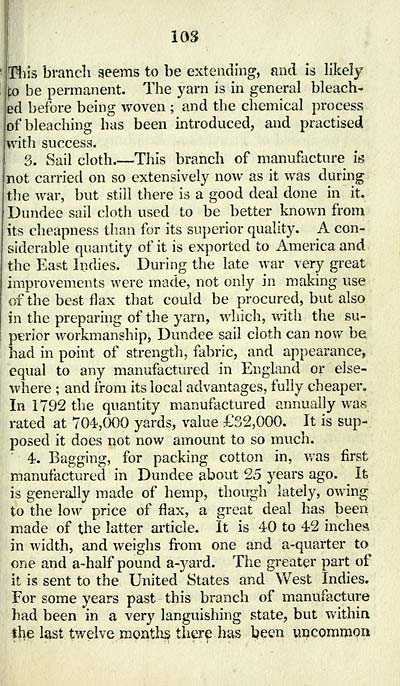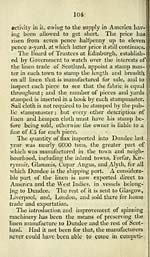Towns > Dundee > 1822 - Dundee delineated; or, A history and description of that town, its institutions, manufactures and commerce
(109)
Download files
Complete book:
Individual page:
Thumbnail gallery: Grid view | List view

10S
his branch seems to be extending, and is likely
|o be permanent. The yarn is in general bleach-
ed before being woven ; and the chemical process
of bleaching has been introduced, and practised
with success.
Sail cloth. — This branch of manufacture m
[not carried on so extensively now as it was during
'jthe war, but still there is a good deal done in it.
Dundee sail cloth used to be better known from
its cheapness than for its superior quality. A con-
siderable quantity of it is exported to America and
the East Indies. During the late war very great
improvements were made, not only in making use
of the best flax that could be procured, but also
in the preparing of the yarn, which, with the su-
perior workmanship, Dundee sail cloth can now be
had in point of strength, fabric, and appearance,
equal to any manufactured in England or else-
where ; and from its local advantages, fully cheaper.
In 1792 the quantity manufactured annually was
rated at 704,000 yards, value £32,000. It is sup-
posed it does not now amount to so much.
4. Bagging, for packing cotton in, was first
manufactured in Dundee about 25 years ago. It
is generally made of hemp, though lately, owing
to the low price of flax, a great deal has been
made of the latter article, it is 40 to 42 inches*
in width, and weighs from one and a-quarter to
one and a-half pound a-yard. The greater part of
it is sent to the United States and West Indies.
For some years past this branch of manufacture
had been in a very languishing state, but within
the last twelve months there has been uncommon
his branch seems to be extending, and is likely
|o be permanent. The yarn is in general bleach-
ed before being woven ; and the chemical process
of bleaching has been introduced, and practised
with success.
Sail cloth. — This branch of manufacture m
[not carried on so extensively now as it was during
'jthe war, but still there is a good deal done in it.
Dundee sail cloth used to be better known from
its cheapness than for its superior quality. A con-
siderable quantity of it is exported to America and
the East Indies. During the late war very great
improvements were made, not only in making use
of the best flax that could be procured, but also
in the preparing of the yarn, which, with the su-
perior workmanship, Dundee sail cloth can now be
had in point of strength, fabric, and appearance,
equal to any manufactured in England or else-
where ; and from its local advantages, fully cheaper.
In 1792 the quantity manufactured annually was
rated at 704,000 yards, value £32,000. It is sup-
posed it does not now amount to so much.
4. Bagging, for packing cotton in, was first
manufactured in Dundee about 25 years ago. It
is generally made of hemp, though lately, owing
to the low price of flax, a great deal has been
made of the latter article, it is 40 to 42 inches*
in width, and weighs from one and a-quarter to
one and a-half pound a-yard. The greater part of
it is sent to the United States and West Indies.
For some years past this branch of manufacture
had been in a very languishing state, but within
the last twelve months there has been uncommon
Set display mode to: Large image | Transcription
Images and transcriptions on this page, including medium image downloads, may be used under the Creative Commons Attribution 4.0 International Licence unless otherwise stated. ![]()
| Scottish Post Office Directories > Towns > Dundee > Dundee delineated; or, A history and description of that town, its institutions, manufactures and commerce > (109) |
|---|
| Permanent URL | https://digital.nls.uk/85825339 |
|---|
| Description | Directories of individual Scottish towns and their suburbs. |
|---|
| Description | Around 700 Scottish directories published annually by the Post Office or private publishers between 1773 and 1911. Most of Scotland covered, with a focus on Edinburgh, Glasgow, Dundee and Aberdeen. Most volumes include a general directory (A-Z by surname), street directory (A-Z by street) and trade directory (A-Z by trade). |
|---|


